The Essential Guide to Poultry Range Feeders Benefits
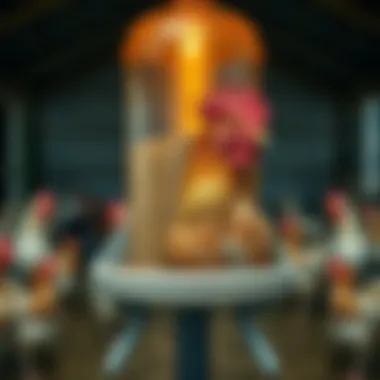
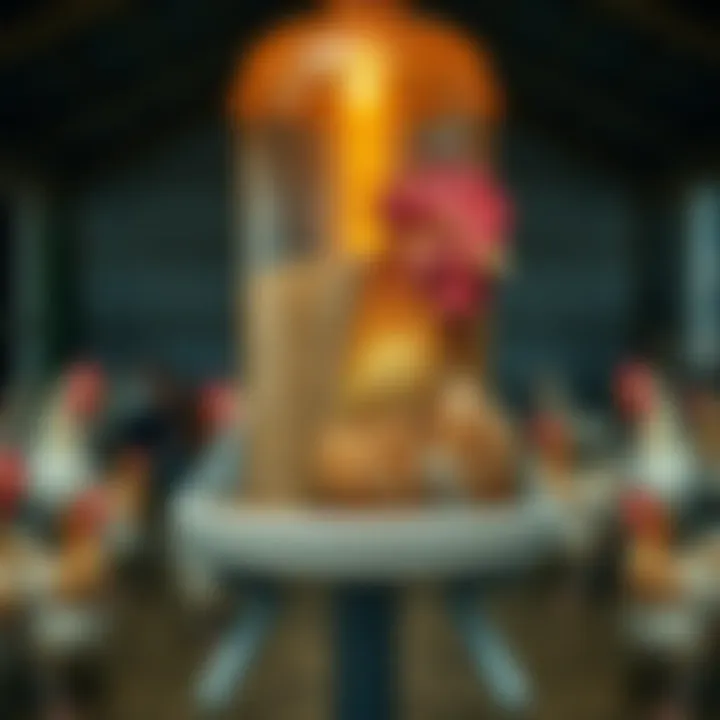
Intro
In the world of aviculture, the importance of proper feeding practices cannot be overstated. Poultry range feeders serve as a vital component in maintaining the health and productivity of poultry. They are not just mere containers for feed; these tools can significantly influence the feeding behavior and nutritional intake of flocks. In this guide, we aim to explore the depth of poultry range feeders, offering insights into their designs, advantages, and the implications for poultry health.
This comprehensive examination will cover various styles of feeders, the benefits they present to both the poultry and the keeper, and the latest innovations in feeder design. If you’re a seasoned poultry keeper or someone just starting out, understanding these aspects will enhance your farming practices and ultimately contribute to a thriving poultry operation. Let's turn the spotlight on poultry range feeders and delve into their pivotal role in modern agriculture.
Prologue to Poultry Range Feeders
In the world of poultry farming, the right feeding systems can make all the difference. Poultry range feeders are not just containers that dispense food; they play a crucial role in the health and productivity of the flock. By ensuring birds have access to quality feed, these feeders contribute significantly to their growth and overall well-being.
When considering poultry nutrition, it’s important to understand that what the birds eat directly impacts their livability rates and productivity metrics. Adequate nutrition supports strong immune systems, which helps prevent diseases that can spread rapidly in flocks. This means that a well-designed poultry range feeder directly correlates with the success of any poultry operation—whether it be a hobby farm or a large commercial endeavor.
Different types of feeders come with unique benefits. Automatic feeders can reduce labor, while gravity feeders ensure a steady supply of feed. Understanding these nuances creates a solid groundwork for addressing the dietary needs of birds. Additionally, selecting the appropriate feeder for specific poultry types, like chickens or ducks, plays a big part in their feeding habits.
Moreover, an informed choice regarding feeders can influence not just the health of the birds, but also the economic viability of the farming operation. With the rising costs of feed and the need for effective practices, making the right decision matters.
To truly appreciate the significance of poultry range feeders, let's delve deeper into the fundamentals of poultry nutrition and the role feeders play in promoting poultry health.
Understanding Poultry Nutrition
Understanding how to nourish poultry is the cornerstone of successful aviculture. Chickens, ducks, and other birds require a balanced diet that includes proteins, carbohydrates, fats, vitamins, and minerals. It’s not just about throwing feed on the ground; proper nutrition requires knowledge and attention.
Feed quality can vary widely, impacting growth rates and egg production. For instance, layer hens need diets rich in calcium to produce strong eggshells, while broilers require proteins for rapid weight gain. In addition, age and breed can dictate specific nutritional needs.
Farmers should consider the nutritional components present in the feed they use. For example, using whole grains versus processed feeds can lead to different outcomes in overall health and productivity. To put it plainly, understanding poultry nutrition ensures farmers can make informed choices about what goes into their birds’ diets.
The Role of Feeders in Poultry Health
Feeders are essentially delivery mechanisms for nutrition. Without proper feeders, birds might struggle to access food, leading to competition and stress within the flock. When feeders are designed to minimize waste and prevent contamination, they create an environment that promotes health and reduces the risk of disease.
Furthermore, the layout of the feed stations can affect feeding behaviors. A well-placed feeder encourages social interaction among birds, which can foster a better flock dynamic. Adequate feeding space is crucial, as overcrowding at feeding stations can lead to pecking and injury, affecting overall health negatively.
In summary, poultry range feeders are vital for not just nutrition but also for fostering a safe and healthy environment for birds. They connect the dots between what birds eat and their overall health outcomes, making them an indispensable part of poultry farming.
"A bird in hand is worth two in the bush"—there's wisdom in ensuring every bird is well-fed and healthy.
Types of Poultry Range Feeders
Poultry range feeders are more than just tools; they serve as the backbone of efficient feeding systems in any aviculture operation. Choosing the appropriate type of feeder can greatly influence the health and productivity of the flock, as it directly affects their feeding behavior, nutrient intake, and overall welfare. In this section, we'll delve into three main types of poultry range feeders: Automatic Feeders, Gravity Feeders, and Trough Feeders. Each type has its unique advantages, considerations, and functionality that cater to different needs.
Automatic Feeders
Automatic feeders represent a modern approach to poultry feeding, leveraging technology to ease the workload of poultry keepers. They function by dispensing feed at set intervals, ensuring that birds have consistent access to nutrition. Here are some notable benefits:
- Efficiency in Feed Distribution: Automatic feeders can cover a larger area, making them suitable for bigger flocks while reducing wasted feed. Often, these feeders use sensors to ensure feed is available only when birds are near, leading to decreased spillage.
- Time Savings: For farmers juggling multiple tasks, automatic feeders save time. Once set up, they require little attention until the feed needs replenishing, allowing farmers to focus on other important aspects of poultry care.
- Reduced Labor Intensity: Less manual feeding means less wear and tear on farmhands and more precision in feeding quantity.
However, there are considerations:
- Upfront Cost: Automatic feeders can be more expensive initially, so careful budgeting is essential to ensure it's a practical long-term investment.
- Maintenance: They may require regular maintenance to address any mechanical problems that could disrupt feeding routines.
Gravity Feeders
Gravity feeders are a more traditional alternative that depend solely on gravity to feed the birds. These devices allow feed to flow down through a controlled opening, keeping it available for chickens to access at their own pace. Here’s what makes gravity feeders appealing:
- Simplicity: Their straightforward design means they are easy to use and set up, requiring no additional power supply or technology.
- Cost-Effective: Generally, gravity feeders are cheaper than their automatic counterparts, making them a popular choice among small-scale poultry keepers or hobbyists.
- Minimal Maintenance: Unlike automatic feeders, gravity feeders don’t have mechanical parts that require upkeep. A simple washage will suffice to keep them clean, which can appeal to those new to poultry farming.
Nevertheless, there are some factors to be aware of:
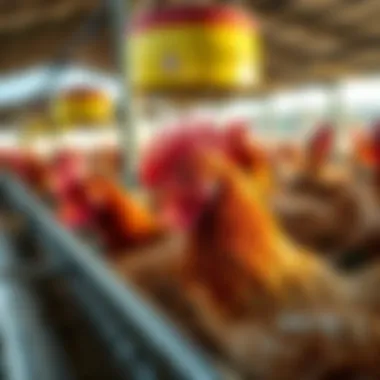
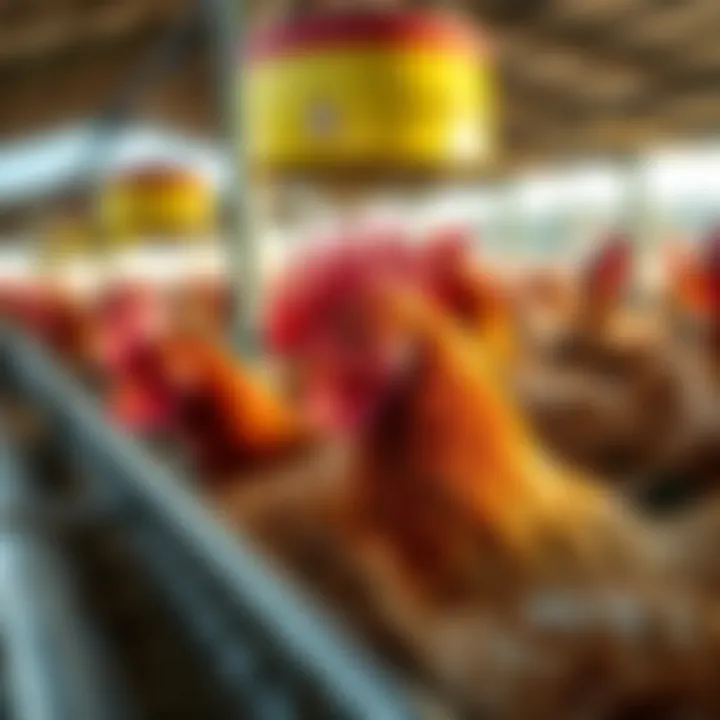
- Potential Waste: Birds may scatter the feed, leading to wastage, especially if the feeder is not properly designed for the bird types being cared for.
- Limited Capacity: Larger flocks may require multiple gravity feeders to meet feeding needs, creating more work in terms of filling and monitoring.
Trough Feeders
Trough feeders are reminiscent of old-time feed setups, structured like long, open containers where birds can freely access food. These feeders are known for specific instances where they shine:
- Social Feeding: The design allows multiple birds to feed simultaneously, which can promote social interaction within the flock. Birds like bantom chickens thrive in this kind of feeding environment.
- Adaptability: Trough feeders can be easily adjusted in length and height according to the flock's size or the types of birds being maintained.
- Easy Monitoring: It is easier to gauge feed quantities and observe feeding patterns, which can help in managing birds' health and nutrition.
Nonetheless, there are drawbacks to consider:
- Vulnerability to Contamination: Since trough feeders are often open, they can be prone to contamination from outside elements like dirt, which can affect bird health if not regularly cleaned.
- Greater Feed Waste: Chickens can dig through feed, leaving some uneaten, especially if not monitored carefully.
Materials Used in Poultry Feeders
Understanding the materials that go into the making of poultry feeders is crucial for both effectiveness and sustainability. With the wide range of environments that poultry can be housed in, the choice of materials plays a pivotal role in maintaining a healthy flock. The right material not only enhances the longevity of the feeder but also contributes to the overall health and safety of the birds. This section will explore the two dominant materials used in feeders: plastic and metal, along with a deeper dive into durability and hygiene standards to help you make informed choices.
Plastic vs. Metal Feeders
When it comes to poultry feeders, the debate between plastic and metal is as old as the chickens themselves. Plastic feeders are often lightweight and easier to move around, making them favored by those who need to frequently relocate their feeding stations. Well-designed plastic feeders can be highly durable, resistant to rust, and don't corrode easily, which means they can withstand the outdoor elements quite well.
However, there are downsides. Plastic can be susceptible to UV degradation when exposed to direct sunlight over long periods. This can lead to cracking and eventual replacement, increasing long-term costs.
On the other hand, metal feeders pack a punch when it comes to durability. Galvanized steel or aluminum options tend to last quite a bit longer and can handle rougher conditions without falling apart. They resist animal pecking better than plastic, making them a solid choice for larger flocks. Yet, they do come with their own set of drawbacks; they can be heavier, making them less portable and more challenging to clean once they’re dirty.
In terms of cost-effectiveness, metal feeders can prove to be more economical over time due to their durability, but the initial investment is usually higher compared to plastic. Additionally, certain circumstances could favor one over the other based on the specifics of your environment or flock. Hence, if you have a farm in a rainy location, plastic might not cut it. Conversely, for dry, sunny conditions, a good quality plastic could suffice. It’s essential to weigh these factors before making a purchase.
Durability and Hygiene Standards
Durability and hygiene are not just buzzwords—they are foundational components of any poultry feeding system. Regardless of the material you choose, ensuring that feeders hold up under day-to-day wear and tear while also being easy to clean is non-negotiable.
"The longevity of your feeder directly impacts your poultry's health; a great feeder is only as effective as the hygiene it maintains."
When considering hygiene, one must ensure that the feeder material does not support the growth of bacteria or fungi, which can lead to illness among birds. Metal feeders can be easier to sanitize due to their smooth surfaces and resistance to damage from cleaning chemicals. A simple wipe down with a disinfectant can do wonders.
Plastic feeders, although convenient, often have grooves and cracks where debris can accumulate, potentially nurturing harmful microorganisms. It's advisable to look for plastic options designed with smooth surfaces or built with bacteria-resistant additives to counteract this risk.
Moreover, some jurisdictions have specific hygiene regulations that dictate the types of materials that can be used in feeders to ensure optimal animal health. Keeping aware of these standards is vital, as it can save you from potential fines or, even worse, health issues in your flock.
Ultimately, making the right choices about materials used in your poultry feeders can significantly enhance both the welfare of your birds and the efficiency of your feeding practices, leading to healthier birds and greater productivity.
Design Considerations for Poultry Range Feeders
When it comes to poultry range feeders, the design isn't just a question of aesthetics or creativity; it's about functionality and the overall welfare of the birds. A well-thought-out feeder can positively influence the feeding patterns and health of poultry, leading to better productivity. Therefore, understanding the critical elements of feeder design becomes paramount for both new and seasoned poultry keepers. In this section, we'll dissect three fundamental aspects of feeder design: capacity and size, accessibility for birds, and protection against the elements.
Capacity and Size
Selecting the appropriate capacity and size of the feeder is not merely about fitting it into the available space; it has significant implications for the feeding habits of chickens. An undersized feeder forces birds to compete for food, which can create aggression and lead to stress amongst the flock. On the other hand, a feeder that is excessively large may not encourage the birds to eat, leading to wasted feed.
- Determine the number of birds: It is essential to establish the total number of birds being fed. Each bird requires a certain amount of feed. As a rough guide, you might consider around four to five inches of feeder space per bird in range systems.
- Assess their age and type: Different breeds and age groups have varying needs. For instance, chicks eat less than mature hens, so a shift in feeder size might be necessary as the flock ages.
- Feeder Volume: Understanding how much feed the feeder can hold is critical. Larger capacities might be beneficial for those who can't refill the feeder daily, ensuring consistent access to nutrition, especially in free-range systems where birds roam extensively.
Accessibility for Birds
Making feeders easily accessible to all birds is crucial for ensuring that each bird gets its fair share. Accessibility encompasses the physical layout of the feeder, as well as its location within the environment where the poultry are kept.
- Design aspects: Consider the height and width of the feeder openings. Feeders must accommodate the size and age of the birds. If the feed is out of reach due to an elevated design, younger or smaller birds may struggle to access nourishment.
- Placement matters: Positioning feeders in shaded parts of the range can encourage birds to eat more, especially during hot weather. Also, it might discourage pests and reduce contamination risk from feces.
- Social dynamics: Introducing multiple feeding stations can ease competition among the flock. A spread-out design allows weaker or less dominant birds to feed without the pressure exerted by more aggressive members.
Protection Against the Elements
A feeder's design must also consider structural resilience against various weather conditions. Whether it's rain, snow, or intense sun, birds need to have access to food that isn’t spoiled or inaccessible due to weather.
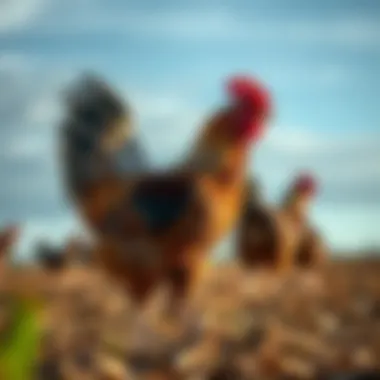
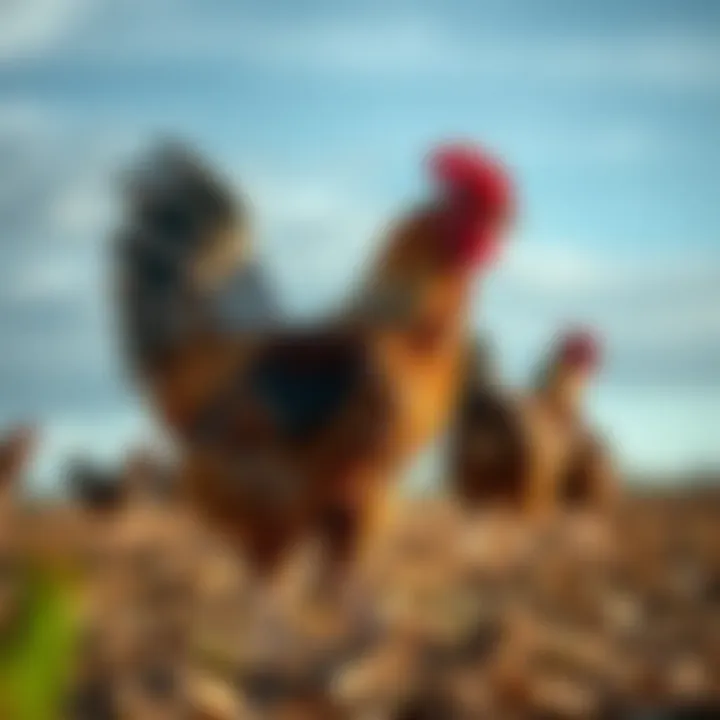
- Scaling against weather: Feeders should be designed with overhangs or roofs to protect feed from rain or direct sunlight, which can cause spoilage or reduce palatability.
- Durable materials: When choosing materials, make sure they are resistant to rust, corrosion, or rot if exposed to moisture. Certain plastics and metals fare better than others in such conditions.
- Wind mitigation: If poultry are housed in open areas, consider structures that can withstand high winds. Instead of free-standing feeders, you might explore enclosed or anchored options that prevent tipping or displacement.
"An optimized feeder design that takes into account size, accessibility, and protection can make a world of difference in ensuring healthy, productive poultry."
Impact of Feeders on Poultry Behavior
When it comes to creating a healthy and productive environment for poultry, the impact of feeders on poultry behavior is a focal point that should not be overlooked. The choices farmers make regarding feeder design and placement have significant implications for the birds’ feeding patterns and social interactions, which in turn affects their overall welfare. Properly designed feeders can indeed facilitate more harmonious living conditions among the flock, leading to enhanced health and productivity.
Feeding Patterns and Social Interaction
The way poultry interact with each other during feeding times can greatly influence their behavior and social structure. With proper feeder design:
- Accessibility plays a crucial role in ensuring that all birds within the flock have fair access to food. If a feeder is too small, dominant animals may hog the space, leading to stress and malnutrition among weaker birds.
- Feeding stations should facilitate natural foraging behaviors. When designing the space, consider using feeders that mimic natural food distribution, encouraging birds to engage in more exploratory and social feeding behaviors. Research indicates that when birds are able to forage in a more natural setting, it leads to a reduction in pecking order issues, thereby increasing overall flock harmony.
Feeding patterns can also indicate social dynamics within the flock. Birds often form hierarchies, and observing who feeds and when can provide insights into these relationships. For example, flocks with ample feeder access tend to exhibit lower levels of aggression, as birds are less likely to fight over food resources.
Stress Reduction and Welfare
Maintaining welfare standards in poultry farming directly correlates to how efficient the feeding design is. Stress in poultry can stem from various sources, and feeders often play a vital role in either alleviating or exacerbating such conditions. Here are some considerations:
- Regular access to food reduces stress significantly. Disruptions in feeding schedules or inadequate feeder capacity can lead to competition and anxiety among the flock.
- Hygiene is a critical factor. Dirty feeders can become breeding grounds for pathogens, causing illness that increases stress in birds. Regular maintenance practices, such as cleaning and inspecting feeders, are paramount in ensuring the well-being of poultry.
- Environmental factors also affect how feeders can reduce stress. Feeders that are protected from rain and extreme temperatures make food more accessible and palatable, encouraging healthy eating habits.
Farmers should consider these aspects carefully. Placing feeders in areas that offer shade during hot weather or shelter from rain can greatly influence behavior and welfare. Providing robust feeders can mitigate these risks, thus enhancing the flock's quality of life.
"A well-fed bird is a happy bird; take care of their feeding needs, and they will take care of your farm's productivity."
By understanding the impact that feeding systems have on poultry behavior, farmers can make more informed decisions that not only support animal welfare but also improve the efficiency of their farming operations. With the right approach to feeder design and placement, the symbiotic relationship between poultry and their feed can significantly enhance the overall health, well-being, and productivity of the flock.
Maintaining Poultry Range Feeders
The upkeep of poultry range feeders is more than a mere task; it is a cornerstone of effective poultry management. Regular maintenance ensures that the feeders function optimally, providing consistent access to food, which is vital for poultry health and productivity. When poultry have reliable access to fresh feed, it not only promotes growth but also minimizes stress and behavioral issues associated with competition for food.
Routine Cleaning Procedures
Keeping feeders clean is essential for various reasons. First off, a clean feeder prevents the buildup of mold and bacteria, which can lead to health issues among the flock. Here’s how you can ensure cleanliness:
- Disassemble the feeder components if possible. This allows for a thorough clean.
- Use warm, soapy water to scrub the various parts, ensuring you remove any debris or residues. Avoid harsh chemicals; they could leave toxic residues.
- Rinse thoroughly to remove any soap remnants, as birds might ingest harmful substances if not rinsed properly.
- Dry completely before reassembling; moisture can encourage mold growth.
- Implement a regular schedule, ideally every week, to ensure that all feeders remain in optimal condition.
By adhering to these procedures, you not only protect your flock’s health but also extend the lifespan of the feeders themselves.
Inspection for Wear and Tear
It is just as important to keep an eye on the physical state of your range feeders. Over time, wear and tear can significantly affect their performance. A worn feeder may botch feeding times or allow waste to accumulate, leading to further complications. Here’s what to look for:
- Check for cracks or breaks in the structure. Any fracture can lead to feed spillage, which not only wastes resources but also attracts pests.
- Look for rust on metal feeders. Rust can eat away at the material, and no one wants rusty food. If rust begins to appear, consider replacing that part or the entire feeder.
- Examine moving parts, like lids or hoppers, to ensure they are functioning smoothly. Stiff or jammed components can frustrate your flock during feeding times.
- Be mindful of hinges and latches; these should operate without excessive force. Sticking or bad latches can lead to feed theft from other animals or wild birds.
Conducting these inspections on a regular basis allows you to catch potential issues early, saving you time and costs in the long run.
Remember, a well-maintained feeder is key to a thriving flock. Regular cleaning and inspection practices ensure that your poultry receives their feed in a healthy and sustainable manner. For more insights on poultry management and feeder standards, consider visiting resources like USDA or the Poultry Science Association.
"An ounce of prevention is worth a pound of cure." Ensuring that your poultry feeders are maintained not only supports the welfare of your birds but also your productivity as a farmer.
Economic Considerations in Feeder Selection
Making the right choice in poultry feeders isn’t just about feeding the flock; it's about laying down a solid foundation for your whole operation’s financial health. When choosing feeders, understanding the economic aspects can greatly affect the profitability and sustainability of poultry farming. It involves examining initial costs, ongoing expenses, and the long-term financial benefits of various feeder options.
Investing in a poultry feeder is not just a one-off cost; it encompasses a broader view of how those feeders will perform over time. It’s crucial to think of feeders as part of a wider economic strategy. A sound feeder choice not only enhances bird health but also translates to better productivity and, ultimately, revenue. Here, we’ll look into the cost-effectiveness of different feeder types and how efficient design can lead to long-term savings.
Cost-Effectiveness of Different Feeder Types
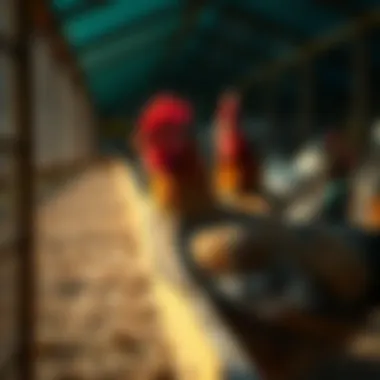
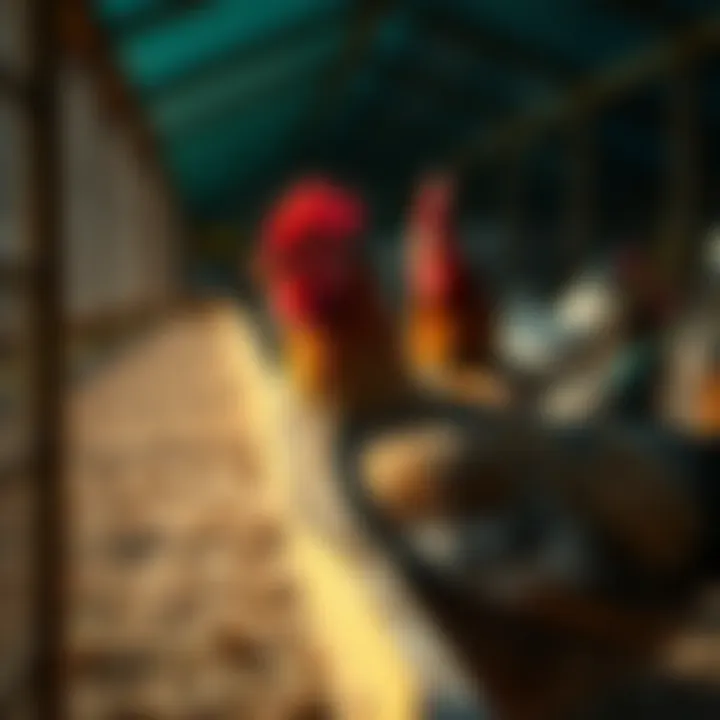
Choosing between different types of poultry feeders can sometimes feel like comparing apples to oranges. Each type—be it automatic, gravity, or trough feeders—brings its own set of economies. For instance, automatic feeders, while perhaps pricier upfront, save significant time and labor costs. With birds being continuously fed throughout the day, you minimize waste and improve feed conversion ratios.
On the flip side, gravity feeders tend to be easier on the wallet at the outset but may require more attention to refill, hence, increasing labor costs in the long run. It’s a classic case of "you get what you pay for."
To determine cost-effectiveness, consider the following points:
- Upfront Cost vs. Long-term Efficiency: How does the initial investment compare to the expected longevity and efficiency?
- Maintenance Costs: Are some feeders prone to repair? Will parts need replacement?
- Feed Waste: What’s the potential for spillage or wasted feed with each type? Less waste means more cost savings.
As a rule of thumb, any penny saved on the cost of the feeder itself can vanish if it leads to feed waste or extra labor hours.
Long-Term Savings Through Efficient Feeding Design
Feeder design isn’t just about aesthetics; it plays a pivotal role in operational efficiency. A well-designed feeder can lead to considerable savings down the line. For instance, a feeder that delivers the right amount of feed at strategic times not only keeps the birds well-fed but also minimizes overconsumption and waste.
Here are some key elements of efficient feeder designs that can contribute to long-term savings:
- Adjustable Feed Height: Allows easy access for growing chicks, reducing the stress of competitors.
- Closed Feed Systems: Helps protect feed from contaminants, therefore preserving feed quality and reducing spoilage.
- Durable Materials: Investing in sturdier materials like galvanized steel rather than plastic can mean fewer replacements and repairs.
These features can enhance feed efficiency and optimize your operations, ultimately trim down your expenses.
"A penny saved is a penny earned."
This proverb highlights the importance of smart investments in poultry feeders.
In summary, making informed choices in the economic realm of feeder selection can set a poultry operation on the right financial path. By considering cost-effectiveness and embracing efficient feeder designs, you can ensure that your poultry operation not only thrives but also remains financially viable in changing markets.
Innovations in Poultry Feeding Systems
In the ever-evolving world of poultry agriculture, innovations in feeding systems represent a crucial turning point for farmers and poultry enthusiasts alike. Many old practices are being replaced with new technologies that increase efficiency, reduce wastage, and ultimately enhance the health of flocks. As poultry producers face challenges such as rising feed costs and the need for sustainable practices, understanding these innovations opens a door to smarter poultry management.
Smart Feeders and Technology Integration
Smart feeders, often equipped with sensors and automated controls, have revolutionized how poultry are fed. These systems monitor feed levels and adjust the dispensing mechanism according to demand. For instance, a smart feeder can dispense food only when birds are present, minimizing waste and ensuring that food is always fresh. Some systems even integrate with mobile apps or farm management software, allowing farmers to track feeding schedules and consumption in real-time. This approach not only saves time but also provides valuable insights into bird behavior and feeding habits.
Here are some of the benefits of smart feeders:
- Reduced Feed Waste: By dispensing the right amount of feed when it's needed, smart feeders can cut down on uneaten grain that might otherwise spoil.
- Improved Health Monitoring: Many smart systems provide data that helps identify trends in feeding behavior, allowing for early detection of potential health issues within the flock.
- Automated Reporting: Farmers can receive alerts on feed levels or potential blockages, making maintenance straightforward and timely.
The adoption of technology in feeding systems is paving the way for smart farming, where precision data guides every decision from feeding to health assessments.
Research on Optimal Feeding Techniques
Recent studies have highlighted the importance of tailoring feeding techniques to maximize both efficiency and nutritional intake. Research indicates that the timing of feed availability and specific feed formulations play vital roles in bird performance and welfare. For instance, studies have shown that implementing staggered feeding times can mimic natural behaviors, reducing competition among birds and allowing weaker individuals better access to feed.
Researchers have also been investigating the impact of feed types on poultry health. For example, introducing varied nutritional profiles at different growth stages can enhance overall growth rates and improve egg production in layers. Incorporating functional additives, like probiotics or enzymes, has also become a focus area, aiming to boost digestion and nutrient absorption.
In summary, keeping an eye on ongoing research is critical for any poultry keeper. By adapting to new findings, producers can refine their feeding systems and contribute to a healthier, more productive flock.
"Innovation is the ability to see change as an opportunity - not a threat." – Anonymous
For more information on poultry feeding systems, consider checking out resources from the USDA or academic publications at Google Scholar.
Culmination
The conclusion serves as the final opportunity to emphasize the vital role that effective poultry range feeders play in both the health and productivity of our flocks. Implementing the right feeding systems isn’t merely a matter of convenience; it’s a crucial element that can significantly influence a farmer's success. Poultry nutrition hinges on consistent access to food that meets the specific dietary needs of the birds at different stages of their development.
Recapping the Importance of Effective Feeding
With a myriad of feeder options available, selecting the most appropriate kind is essential for optimizing feed intake while minimizing wastage. Effective feeding systems can:
- Enhance Growth Rates: Properly designed feeders allow birds to consume feed without limit, fueling their growth and overall development.
- Improve Flock Health: Regular access to quality feed promotes stronger immune systems and healthier birds. When chickens aren't competing for food or struggling to reach feeders, stress levels decrease, contributing to overall well-being.
- Reduce Feed Costs: By preventing waste, farmers save money in the long run. Feeders that are tailored to prevent spillage or contamination can significantly lower expenditure on feed.
- Foster Natural Behaviors: Functional feeders enable social feeding practices, which allow birds to express natural behaviors, making for a happier, more productive flock. The consistent presence of feed prevents rivalry and aggression among birds.
Future Directions in Poultry Feeding Practices
As agriculture leans toward more technology-driven solutions, the future of poultry feeding holds exciting possibilities. Innovations such as smart feeders, which utilize sensors and IoT technology, can revolutionize feeding practices. These feeders can monitor feed levels and bird behavior, enabling farmers to make data-driven decisions that boost productivity.
Furthermore, ongoing research into optimal feeding techniques continues to unfold. Efforts are being directed at understanding how various feed formulations impact poultry behavior and health in invaluable ways. The integration of precision feeding—tailoring feed ingredients to meet the exact needs of birds at various stages—could represent a leap forward in poultry nutrition.



